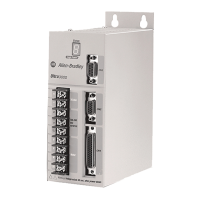248 Rockwell Automation Publication 2094-UM001J-EN-P - March 2017
Appendix D Configure the Load Observer Feature
Tuning Mode Summary
This table summarizes the primary difference between the two tuning modes.
Table 129 - Tuning Mode Comparison
Manual Tuning for Further Optimization
The out-of-box and auto-tune rigid methods achieve relatively high
performance. However, the manual tuning method can help to optimize
performance for the auto-tune compliant method, or if every ounce of
performance is required. It involves incrementally increasing controller gains to
the point of marginal stability, then backing them off by a given percentage.
Typical ranges for various gains are also given to provide guidelines.
Follow these steps to manually tune your drive.
1. Select a factor (N) that you can incrementally increase the gains by in an
iterative process, for example, 1.5>N>2.
2. Create a trend to monitor Torque Reference.
3. Manually tune the velocity loop.
a. Make note of the Position and Feedforward Gains.
You must change them temporarily to isolate the velocity loop and
later restore them to the original values.
b. Isolate the velocity loop.
• Zero out the Position Proportional Gain, Position Integral Gain,
and Acceleration Feedforward Gain
• Set the Velocity Feedforward = 100
c. While Jogging the axis and monitoring the Torque Reference trend,
incrementally increase the following gains simultaneously and stop
when the Torque Reference begins to become oscillatory or unstable:
• Low-pass Output Filter Bandwidth = Low-pass Output Filter
Bandwidth x N
• Load Observer Proportional Gain = Load Observer Proportional
Gain x N
• Load Observer Integral Gain = Load Observer Integral Gain x N
• Velocity Proportional Gain = Velocity Proportional Gain x N
• Velocity Integral Gain = Velocity Integral Gain x N
2
Tuning Mode Description
Out-of-box or unknown load
Load Inertia Ratio = 0
Load Observer Bandwidth Kop = 4 times the new Velocity Proportional Gain, Kvp
Auto-tuning or known load
Load Inertia Ratio > 0
Load Observer Bandwidth = Velocity Proportional Gain

